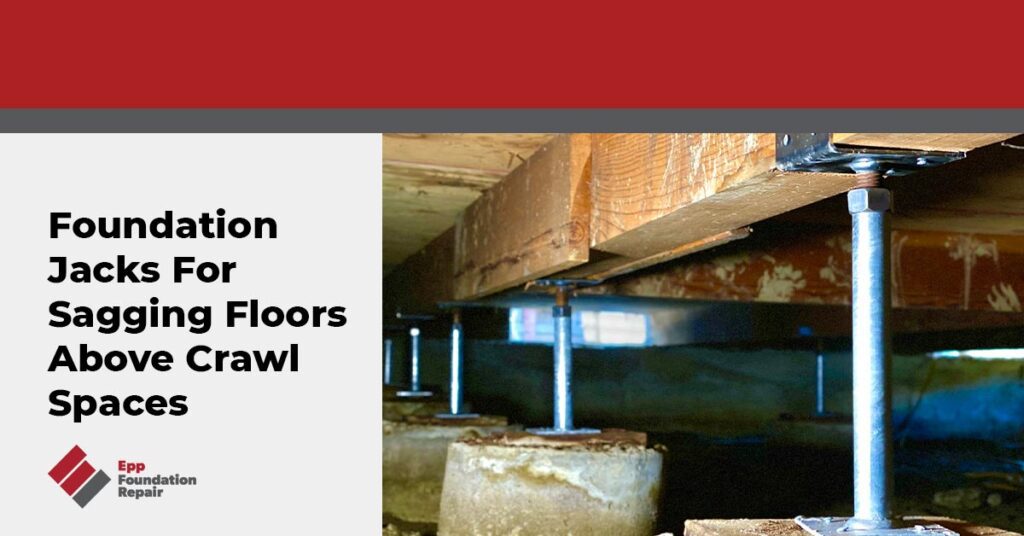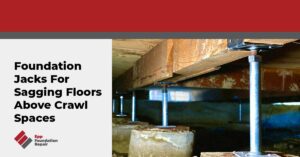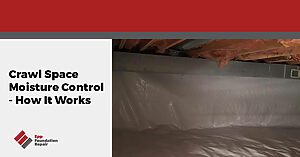What Are Foundation Jacks And When Do You Need Them?
Foundation jacks are used to support and lift up sagging floors above crawl spaces. The floors are usually sagging because either the support posts or existing foundation jacks have deteriorated. Foundation jacks for sagging floors are adjustable and come in different types and sizes.
Why Do Floors Above Crawl Spaces Sag?
Usually, floors above crawl spaces sag because the support posts holding up the crawl space have settled into the ground and are no longer vertical. This could happen for various reasons including problems with the soil. The soil might be weak and unable to support the posts, or it might be expansive. Expansive soil contains a lot of clay and swells when it soaks up moisture and then shrinks when it dries out. This creates movement in the soil which can cause support posts to become uneven over time.
Drainage problems around the foundation can also cause floors above crawl spaces to sag. This happens when the support posts sink into the soft, water-saturated soil in the crawl space.
Other reasons a floor might sag above a crawl space and require foundation jacks include:
- The existing foundation jacks weren’t protected from corrosion and have deteriorated due to moisture.
- The wooden support posts have rotted. This might be mold, wood rot, wood-eating pests or something else. Damp crawl spaces are the perfect petri dish for mold and pests.
- There aren’t enough support posts in the crawl space. In this case, the solution would be to add more posts.
Signs You Might Need Foundation Jacks
The following are all signs of a problem in the crawl space which might require foundation jacks to fix:
- Your floor is sagging.
- Your floor feels spongy when you walk on it.
- Squeaky floor
- Furniture shakes when you walk by
- There’s mold on the floor or baseboards above the crawl space
- Your home smells musty
- The floor above the crawl space is warped
- You have a problem with pests
If you see any of the above – or anything else that seems suspicious – contact a foundation repair contractor right away and ask for an evaluation.
Repairing A Sagging Floor Using Foundation Jacks
Repairing a sagging floor using foundation jacks is a fairly straightforward procedure. Once the jacks are in place, the floor is supported immediately and if there’s any future settlement, the jacks can be adjusted.
But, depending on the reason for the sagging floor, merely using foundation jacks to lift and level the floor might not be enough. For example, if the support posts settled due to soggy soil caused by poor drainage around the foundation, this problem needs to be fixed. If it isn’t, the same thing will happen again. For more information on proper drainage around a foundation see, The Importance Of Proper Foundation Drainage Around Your Home.
What About DIY Repairs Using Foundation Jacks?
Installing foundation jacks to fix a sagging floor is a job best left to the pros. Crawling around in a crawl space is dangerous and if you don’t know what you’re doing, you could get hurt. Never enter a crawl space without wearing protective gear, including a respirator. For more information, check our blog about – Sagging floor repair cost.
How To Prevent Foundation Problems
Believe it or not, water causes the vast majority of foundation problems. Therefore, you can do a lot to prevent trouble by simply getting groundwater under control around the foundation. Here are a few ways to do that:
- Regrade your yard, if necessary, so that it slopes away from the foundation. This is to prevent water from draining toward and soaking the soil around the foundation.
- Clean your gutters regularly so that runoff doesn’t spill over the side of the house and soak the ground around the foundation.
- Don’t plant flowers, shrubs, trees, or other types of vegetation next to the house. Sure, they look nice. However, they need water and that means you’ll be adding moisture to the soil around the foundation.
- Consider using downspout extensions to carry water at least four feet from the house before releasing it. Downspout extensions are inexpensive and easy to install.
- Install an underground downspout and pop-up emitter. Runoff flows into the underground downspout and channeled toward the pop-up emitter situated 10 feet or so away from the foundation. When the pop-up emitter fills with water, it pops up and releases the water away from the foundation.
- Install a drain tile system. A drain tile system is a gold standard when it comes to foundation waterproofing. For more information on how they work see, How Does A Drain Tile System Work?
If you think there might be a problem in your home’s crawl space requiring foundation jacks, and you’re in our service area, contact us today for a crawl space evaluation.







